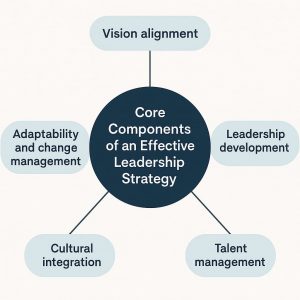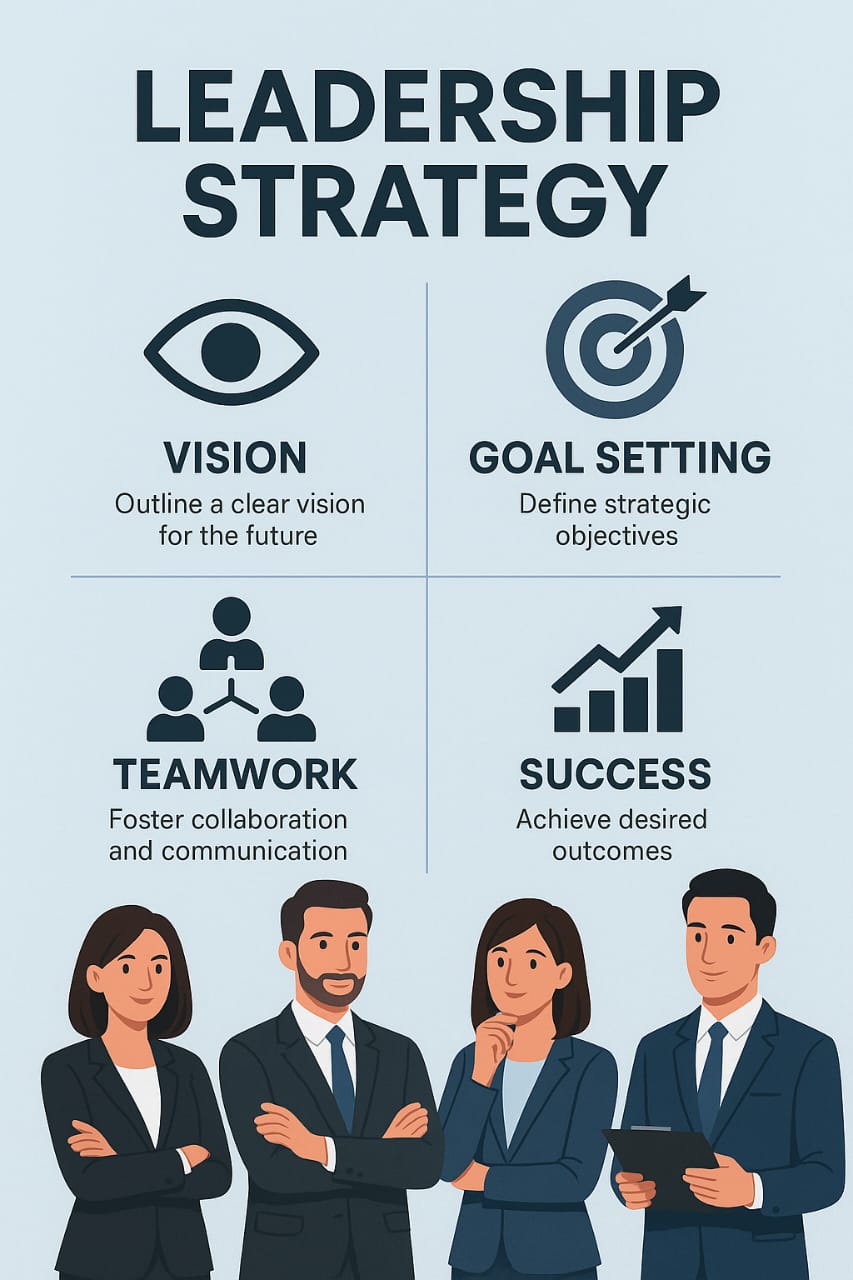Capable leaders can engage employees to influence and encourage excellent performance that helps organizations achieve objectives. They can use leadership strategies to increase the company’s chances of meeting objectives. Learning about the various leadership methods can help you understand how leaders build their ability to influence action, create a productive culture and minimize risks. In this article, we define what leadership strategies are, list examples of them and outline the benefits of effective leadership.
At The Leadership Academy, we believe that a strong leadership strategy is not just about managing people it’s about inspiring teams, setting clear visions, and achieving sustainable success.
What is Leadership Strategy?
Leadership Strategy is a comprehensive plan that defines how leaders within an organization will guide, motivate, and manage teams to achieve business goals. It aligns leadership behaviors, development programs, and decision-making with the organization’s mission, culture, and long-term objectives.
Unlike operational strategies that focus on day-to-day execution, leadership strategy ensures the right leadership capabilities are developed and deployed at every level of the organization. It’s about building a leadership pipeline, empowering future leaders, and fostering a culture of accountability and growth.
Why Leadership Strategy Matters
Without a clearly defined leadership strategy, organizations may experience:
- Low employee engagement
- High turnover rates
- Misaligned goals between departments
- Weak succession planning
- Stagnant innovation
A robust leadership strategy offers direction, unites teams under a common vision, and prepares organizations for future challenges.
At The Leadership Academy, we emphasize strategic leadership training that blends theory with real-world practice. This equips our learners with the skills to adapt, communicate, and lead through uncertainty.
Core Components of an Effective Leadership Strategy
- Vision Alignment – Every great leadership strategy begins with a clear vision. Leaders must understand and communicate the organization’s goals, mission, and values. This sets the tone for strategic decision-making and team alignment.
- Leadership Development – Developing current and future leaders is critical. This includes coaching, mentorship programs, leadership workshops, and formal training like those offered at The Leadership Academy.
- Talent Management – Effective leadership involves identifying and nurturing top talent. Through structured succession planning and performance management systems, organizations can create a strong leadership bench.
- Cultural Integration – Your leadership strategy must reflect the company’s culture. Whether the focus is innovation, collaboration, or customer service, leaders must embody those values in daily operations.
- Adaptability and Change Management – In a world of constant change, leaders must remain agile. A strong strategy builds resilience and prepares leaders to pivot when market conditions shift.

Benefits of a Well-Defined Leadership Strategy
- Promotes teamwork – A good leadership strategy helps employees and teams complement each other’s efforts as they pursue organisational objectives. You can communicate the company’s vision to your team and work with them to align their activities and goals with the organization’s vision. A strategic leader recognizes why delegating and empowering employees is crucial to success and actively engages participants in processes. The manager inspires teams or employees to work together towards common goals.
- Enhances Employee Engagement – Leaders who communicate clearly and lead with purpose inspire loyalty. An effective leadership strategy prioritizes relationship-building and emotional intelligence key elements in today’s workforce.
- Improves Decision-Making – Strategic leaders consider long-term consequences, align decisions with company goals, and balance risk. They lead proactively rather than reactively.
- Drives Innovation – An empowered leadership team promotes creativity and risk-taking. This results in new ideas, products, and solutions giving organizations a competitive edge.
- Strengthens Brand and Reputation – Leadership directly affects how clients, investors, and partners view your brand. Strong leaders uphold your values and build trust with stakeholders.
How The Leadership Academy Helps Develop Leadership Strategy
At The Leadership Academy, we specialize in transforming managers into strategic leaders. Our approach to leadership development includes:
- Leadership Strategy Training – We offer hands-on workshops and customized corporate programs focused on building strategic thinking, problem-solving, and vision alignment.
- Executive Coaching – Our one-on-one coaching sessions help senior leaders refine their leadership styles, improve communication, and drive organizational transformation.
- Emotional Intelligence Development – EQ is at the core of impactful leadership. Our programs develop leaders‘ self-awareness, empathy, and social skills—fostering better workplace relationships.
- Strategic Planning Facilitation – We assist leadership teams in crafting clear, actionable strategic plans. From goal setting to performance metrics, we ensure alignment across all levels.
- Online Courses and Certifications – Through flexible e-learning options, professionals can access leadership strategy courses from anywhere in the world. Our certifications are recognized and valued by top organizations globally.
Leadership Strategy for Different Levels of Management
Frontline Leaders
These leaders are often the face of your organization. Training them in conflict resolution, time management, and team motivation is essential. Our programs at The Leadership Academy offer foundational leadership strategy insights to prepare them for higher roles.
Mid-Level Managers
They bridge the gap between strategy and execution. They must be able to interpret top-level decisions, manage teams, and align with long-term goals. Our strategic leadership programs develop critical thinking, delegation, and performance tracking skills.
Senior Executives
C-suite leaders need a macro view of business and strategy. We help executives lead mergers, transformations, and market expansion with a confident and strategic mindset.
Key Trends in Leadership Strategy (2025 and Beyond)
To remain relevant, leadership strategy must evolve. Here are some emerging trends:
Hybrid and Remote Leadership
Leaders must master digital collaboration and manage distributed teams without compromising productivity.
Diversity, Equity, and Inclusion (DEI)
A strategic approach to inclusive leadership ensures diverse perspectives and better decision-making.
AI-Powered Leadership Analytics
Leveraging data to identify leadership gaps, predict performance, and tailor development programs.
Purpose-Driven Leadership
Employees now seek meaningful work. Leaders must connect business goals with personal values and societal impact.
Mental Health and Wellbeing Focus
Leaders must prioritize empathy, work-life balance, and psychological safety in the workplace.
Final Thoughts: Why Leadership Strategy with The Leadership Academy
Leadership isn’t just about having authority it’s about influence, clarity, and vision. A well-crafted Leadership Strategy ensures that individuals at every level of your organization are aligned, empowered, and equipped to lead effectively.
At The Leadership Academy, we don’t just teach leadership we shape leaders who can navigate complexity, inspire teams, and deliver results.
Ready to transform your organization through strategic leadership?

